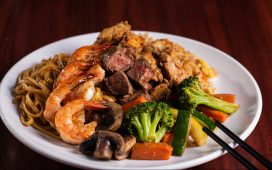Table Of Contents
It is interesting to find out that meat lovers differ when it comes to preferring certain steak cuts. You might be misled to believe that every cut of the meat is essentially just meat. Which is apparently true, but, as it turns out not all cuts of steak are created equal, and sometimes not having the right cut can mean angry, or at least an unsatisfied, diner.
Then there are questions of cooking to consider when cutting steak. For example, a skirt steak is ideal when stir-fried because it’s thin and cooks quickly. Flank steak is better reserved for the fajitas because of its chewiness.
Steaks come in many shapes, cuts, and sizes. Steaks are chosen even on the basis of how they will be cooked. Choosing a steak cut involves considering questions like, whether or not you like a strip of fat attached? What flavors would you like to introduce into the recipes? And, what pricing options are you willing to explore?
Then you have to consider whether you like your steak grilled, stir-fried or sautéd, or slow-cooked in an oven or stovetop.
One thing that remains common to all steaks, however, is that they are delicious. So, if you are planning a dinner party or inviting some guests over, and want to show them that you know your steaks well, the first thing you need to understand is which steak cut to choose.
A true food connoisseur lives for the perfect food experience, no matter where they are. Downtown Gatlinburg, in Tennessee, is the mecca for southern-style steak cooking.
From all the places to eat in Gatlinburg, you’ll be hard-pressed to find a steakhouse as traditionally southern and dedicated to the unique art of steak-cooking as Peddler’s.
How to choose the perfect steak cut?
Steak cuts are hotly debated among carnivores. Some like their cuts with a bit of fat, some like them served on the bone, while others without. Choosing a proper cut of steak is, therefore, a task that requires some expertise.
Plus, you will have to make your choices based on several criteria: cut shape, size, price, and cooking methods and contraptions used.
Ideally, you’d want the best steak that money can buy. The most widely sought-after steaks are the ones with marbling, which is a measure of how much fat is distributed throughout the meat fibers of the steak.
You can choose between beef, lamb, pork, and even fish steaks. Depending on your preferences, ask for flavorful sauces or seasonings along with your steak.
Here are some of the most popular steak cuts you should know:
- Porterhouse
- T-Bone
- Rib Eye
- Filet Mignon
Porterhouse:
Porterhouse and the T-bone steaks are pretty similar in shape; the only thing that differentiates the two is size and thickness. The porterhouse cut has more meat on one half than the T-bone (porterhouse cuts have two meat halves straddling a T-shaped bone.)
Most porterhouse steaks are 3-inches wide, providing enough mouthfuls of juicy, sizeable and delectable salty meat flavors.
The porterhouse cuts are more expensive than other steak cuts. Not only are they costly, but they are also trickier to cook. But if you know how to cook a T-bone, you already know how to cook the porterhouse steak as well; the only caveat being that you need to let it cook longer than the T-bone steak.
T-Bone:
As described, the T-bone and the porterhouse come in the same shape but differ in size and thickness. The T-bone is usually cut from a cow’s loin. These steaks are steak lover’s ideal choice.
T-bone running up the length of the steak is straddled by two different types meat: the tenderloin and the strip steak.
Therefore, the T-bone offers you the taste of two steak flavors in one cut. Commonly, the T-bone steak is between one to two-inches thick. The T-bones are also an expensive cut as compared with others.
In addition, cooking a T-bone requires some special skills, since cooking two different parts of meat, joined in the middle by a bone, requires a certain level of expertise.
Rib Eye:
The rib eye cut is taken from the prime rib area of a bull; it usually comes boneless or with the rib bone attached, and is also known as the cowboy steak. It is chockfull with meat and fat, making it one of the most intensely flavored steak cuts.
The rib eye cuts are usually 0.75 and 1.5-inches thick, but the 1.5-inches cut is excellent for grilling.
The rib eyes are not as expensive as the porterhouse or T-bone steaks. Usually, the price will differ for these cuts depending on whether you buy one with the bone or without.
Filet Mignon:
The filet mignon looks fantastic in the pan when engulfed with bacon. Filet mignon is steak royalty, and the most expensive cut of them all.
It is carved out of the tenderloin, which starts from the ribs and ends toward the cow’s rear. These cuts are carefully carved out in small sections from the tenderloin.
The filet mignon comes in 2 to 3-inches of thickness, which is absolutely perfect when you want to grill your steak. In addition, these cuts are boneless and thicker than the other steaks, so they require more time to cook.
Conclusion:
Choosing the perfect steak cut, when so many options compete for your attention, can be challenging. With so many different steaks, each with a different cut, size, shape, thickness, and price range, a food connoisseur might feel inundated and hard-pressed to choose. Depending on your preferences, cooking style and cooking contraptions used, sauces and flavors available, and other considerations, you would be inclined to choose certain cuts over the others. The guide above was a rundown of the most common and famous steak cuts you could explore to satisfy your gastronomical fantasies.






